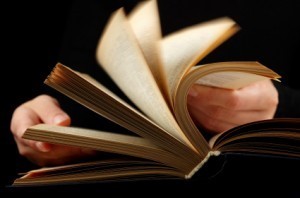 After the nature documentary we walk down,
After the nature documentary we walk down,
into the plaza of art galleries and high end clothing stores
where the mock orange is fragrant in the summer night
and the smooth adobe walls glow fleshlike in the dark.
It is just our second date, and we sit down on a rock,
holding hands, not looking at each other,
and if I were a bull penguin right now I would lean over
and vomit softly into the mouth of my beloved
and if I were a peacock I’d flex my gluteal muscles to
erect and spread the quills of my cinemax tail.
If she were a female walkingstick bug she might
insert her hypodermic proboscis delicately into my neck
and inject me with a rich hormonal sedative
before attaching her egg sac to my thoracic undercarriage,
and if I were a young chimpanzee I would break off a nearby treelimb
and smash all the windows in the plaza jewelry stores.
And if she was a Brazilian leopardfrog she would wrap her impressive
tongue three times around my right thigh and
pummel me lightly against the surface of our pond
and I would know her feelings were sincere.
Instead we sit awhile in silence, until
she remarks that in the relative context of tortoises and iguanas,
human males seem to be actually rather expressive.
And I say that female crocodiles really don’t receive
enough credit for their gentleness.
Then she suggests that it is time for us to go
Do something personal, hidden, and human.
Tony Hoagland is an American poet and writer from North Carolina. I was first introduced to Hoagland’s poetry by his poems included in the recently published Ecopoetry Anthology edited by Ann Fisher-Wirth and Laura-Gray Street. I found Hoagland’s poetry to be thoughtful, humorous, but also very thought provoking. His poem “Wild” featured in the anthology explores human behavior as group of bears migrate into a small valley town, putting them in the place of the human residents. In a similar way, his poem “Romantic Moment” connects human and animal behavior in regards to affection, challenging what we would consider “normal” affection.
“A Romantic Moment” challenges our typical view of human affection by providing an animal contrast, using descriptions of place in the poem to mark the difficulties in connecting human behavior to the behavior between animals. The poem places the behavior of a young couple on a date, illustrating their reaction to images of different species engaging in displays of affection and interest. The boy on the date describes that a bull penguin would, “…lean over / and vomit softly into the mouth of my beloved” (7-8), to express affection. Hoagland provides many explicit images like this throughout the poem in contrast to the simplicity of the human affection of “Holding hands, not looking at each other” (6), challenging the reader to think about the normality of certain human behaviors in contrast to other species. Hoagland uses the very last line of the poem, “Do something personal, hidden, and human”(27), to illustrate the disconnect with nature that is the overarching problem throughout the poem. The couple’s last words display a bias in judgment about what acceptable human behavior is but also more importantly displays the fear of being connected to the complex and sometimes wild aspects of nature.
Hoagland’s poems often challenge human views of behavior, and this one in particular causes me to think about the human display of affection in a new way. Poems that challenge the typical social or structural constructs are often found to be the most interesting and thought provoking types of poetry. Which poems do you find similarly provocative?




